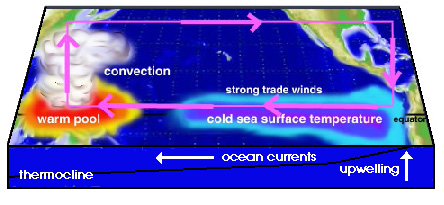


La Niña is marked by strong trade winds, driven by a strong pressure gradient. Cold water propagates to the west via Rossby Waves, and the warm pool of water that occurs in the western Pacific is shifted even more to the west, and with it, the convection, which alters the global weather pattern. The La Niña weather patterns are not necessarily equal and opposite to the El Niño weather patterns.
Convection is driven by the warming of the surface air over the warm water; as the warm pool is shifted westward during a La Niña, so does the heavy rains caused by the convection. The shift in the weather patterns is what causes drought, floods, storms, and other weather anomalies in many area of the world.
The following graphic shows the temperature distribution in the Pacific Ocean for a La Niña.
Dec. 1988 |
 |
 |
A good way to understand the changes from a normal scenario to an El Niño or a La Niña is to see all three illustrations.